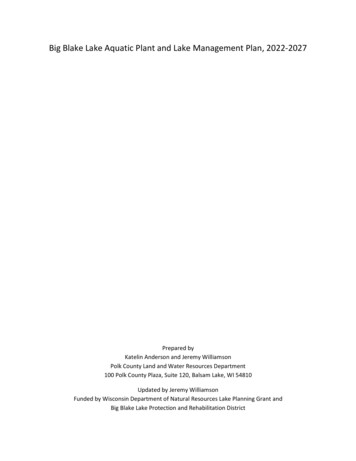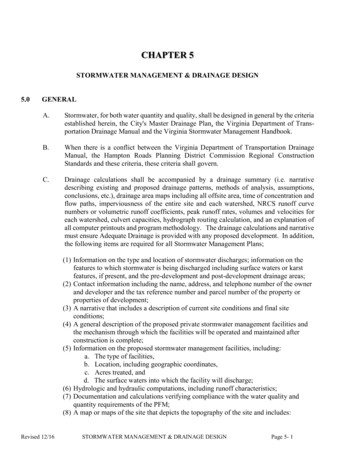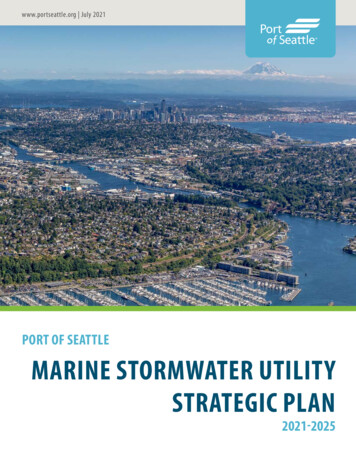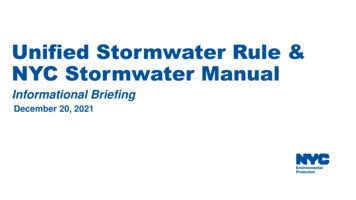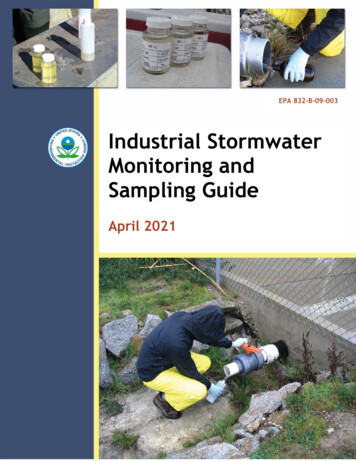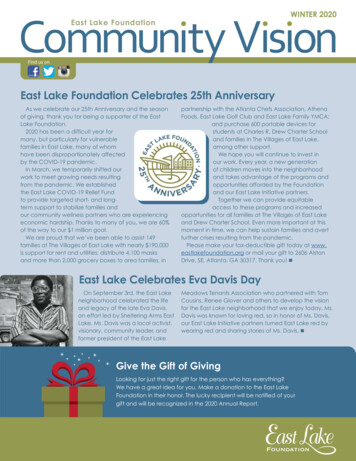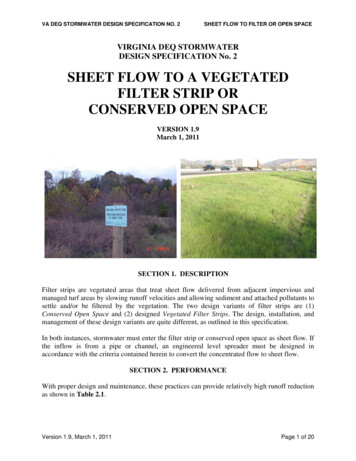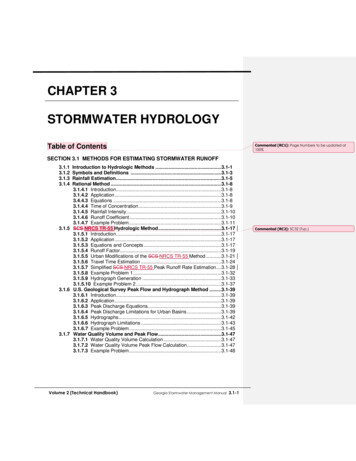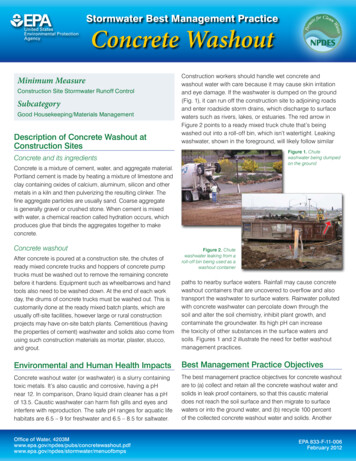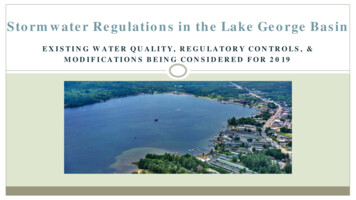
Transcription
Stormwater Regulations in the Lake George BasinEXISTING WATER QUALITY, REGULATORY CONTROLS, &MODIFICATIONS BEING CONSIDERED FOR 2019
What is the Lake George Park Commission?The Lake George Park Commission is a NYS agencyestablished to oversee and manage the unique resources ofthe “Lake George Park” especially the lake’s superior waterquality.To do so, the Commission is conveyed special authority andresponsibility by New York State. The Commission’sprograms fill critical gaps to ensure the lake’s protectionand encourage cooperation among the many public andprivate entities whose common goal is the lake’spreservation.
Stormwater Runoff and Water Quality “Nation’s largest source of waterquality problems”, EPA Pollutants in stormwater runoffare the single largest impact toLake George water quality andclarity Primary pollutants: phosphorus,nitrogen, sediment, chlorides
Science, Not Opinion Studies documenting this fact are many,including National Urban Runoff Program – LakeGeorge Report (1983) The Plan for the Future of the Lake GeorgePark (1987) Stearns and Wheeler Phosphorus BudgetReport (2001) State of the Lake Report – 30 Years of LGMonitoring (2014) Many more
Reductions in water clarity Lakewide, transparency has shown a decline of 6% over 30 yearsSource: “The State of the Lake Water Quality: Highlights of Over 30 Years of Research 1980-2013”, presentation by Lawrence Eichler, Darrin Freshwater Institute
Reductions in water clarity Secchi disk data show a decline in transparency over timeRate of decline is similar in all basinsA clear south to north gradient in transparency is presentDifference of 1.6 m from south to northIncreased algal production may account for the differenceSource: “The State of the Lake Water Quality: Highlights of Over 30 Years of Research 1980-2013”, presentation by Lawrence Eichler, Darrin Freshwater Institute
Increased Chlorophyll Levels Observed Chlorophyll increased lake-wide by 33% over 30 yearsIndicative of increased primary productivitySource: “The State of the Lake Water Quality: Highlights of Over 30 Years of Research 1980-2013”, presentation by Lawrence Eichler, Darrin Freshwater Institute
Increased Chlorophyll Levels Observed Chlorophyll levels show a strong south to north gradient The differences between basins are increasing over timeSource: “The State of the Lake Water Quality: Highlights of Over 30 Years of Research 1980-2013”, presentation by Lawrence Eichler, Darrin Freshwater Institute
Trends in Water Quality Correlate with Development Similar to water quality, land development has a strong south to north gradient Areas with more development are associated with decreased water quality In the south basin, 19% of the watershed contains 43% of the hardscape/imperviousSource: “Lake George Watershed Atlas”, 2016, Lake George Association
We can do Better & We have been doing Better History of Public works projects NYS DOS and NYS DEC grants 10 million to Lake George projects inthe past decade. More than any other lake in NYS Significant funds directed to addressrunoff from highways, local roads, pubicproperties Great partnerships State, County, Town, SWCD, LCLGRPB,Fund, LGA
We can do Better & We have been doing Better Great local, professional resources Educate the communityIncentivize water qualityimprovement projects & designFacilitate projects Examples Fund’s Do It Yourself Water QualityLGA’s Lake Saving ProjectsWCSWCD’s Watershed & RetrofitAssessments
Systematic Approach: Commission Stormwater Regulations Effective September 1990 Key Elements Low Threshold of Jurisdiction1,000 sqft of new impervious area, or 5,000 sqft of land disturbance Post Construction SWCM’s LimitingOffsite Impacts through onsiteVolume Control
Commission Stormwater Regulations Minor Projects 15,000 sqft land disturbanceInfiltration Device Performance: 1.5 gallons / sqft Impervious Area Major Projects 15,000 sqft land disturbanceAkin to Full SWPPPInfiltration Device Performance 10-yr/24-hr Storm Volume25-yr/24-hr Storm RateRetrofit existing development
Bending The Curve on the Lake’s WQ Trends For the first time in 20 years, theCommission is conducting a fullevaluation of its regulations, andseeing where they can be improved Current condition still leads toslow decline How do we change? Timber Harvesting Fertilizers SW Device Setbacks SW Retrofits Stream Corridors
Proposed Changes to the Regulations:Five Key Provisions
1. Timber Harvesting Regs already require conservation plans,but approved by outside parties. New regulation will require LGPC ordelegated municipality to approve loggingplans before activity occurs Logging regulations not well understoodor followed: Enforcement more commonthan compliance Maintain existing standards, achieveimproved results: Less violations, betterpractices on the land
2. Fertilizer Restrictions Reduce nutrient inputs No lawn fertilizer applicationswithin 50 feet of a waterbody Apply Queensbury and LakeGeorge fertilizer code to the entirewatershed
3. Reduced Setbacks forStormwater Practices Working to support all changesbased on best science available Reduce setbacks for major projectsfrom 100’ to 35’ from shoreline,stream or wetland Provides for much greater designflexibility for owners andengineers while not impactingwater quality
4. Retrofitting: Making it Better Apply existing retrofit standard to alljurisdictional projects Currently only applies to Major Projects,extend to Minor ProjectsInfiltrate existing stormwater from a siteDevices sized for minimum volumecontrol of 0.5” from all impervious areas Simple fixes Trenches Swales Rain gardens Low cost, great impact
Retrofitting: Making it Better Apply existing retrofit standard to alljurisdictional projects Currently only applies to Major Projects,extend to Minor ProjectsInfiltrate existing stormwater from siteDevices sized for minimum volumecontrol of 0.5” from all impervious areas Simple fixes Trenches Swales Rain gardens Low cost, great impact“Lake George Watershed Atlas”,2016, Lake George Association“Do It Yourself Water Quality”, 2010 Fund for Lake George, LG Waterkeeper
5. Stream Corridors:Apply 35’ Shoreline Cutting Standard Multiple benefits of stream buffers Reduce sediment, nutrients, stream bankerosion, flood impacts, stream temps,etc. Balance protection & property rights Proposal: Apply APA shoreline cutting standards toDEC streamsNo impervious area within 35’ buffer Established, well-understood standard Queensbury & Bolton currently apply thecutting standard to streams Removal Efficiency: TSS: 53-95%,Total P: 46-79%Total N: 48-74%
Stream Corridors Multiple benefits of stream buffers Reduce sediment, nutrients, stream bankerosion, flood impacts, stream temps,etc. Balance protection & property rights Proposal: Apply APA shoreline cutting standards toDEC streamsNo impervious area within 35’ buffer Established, well-understood standard Queensbury & Bolton currently apply thecutting standard to streams Removal Efficiency: TSS: 53-95%,Total P: 46-79%Total N: 48-74%
Stream Corridors Multiple benefits of stream buffers Reduce sediment, nutrients, stream bankerosion, flood impacts, stream temps,etc. Balance protection & property rights Proposal: Apply APA shoreline cutting standards toDEC streamsNo impervious area within 35’ buffer Established, well-understood standard Queensbury & Bolton currently apply thecutting standard to streams Removal Efficiency: TSS: 53-95%,Total P: 46-79%Total N: 48-74%Source: “A Review of the Scientific Literature on Riparian Buffer Width, Extent, and Vegetation”, 1999, Wenger
Bending The Curve Each proposed element is a simple, commonsense, balanced approach Timber HarvestingFertilizersSW RetrofitsStream Corridors Not overly burdensome to landowners In concert, these items will collectively strengthenstormwater regulation and improve water qualityin the long term Working long-term to slow and ultimately reversethe downward water quality trend in the lake
Timeframe 2017 and early 2018 – Conductseveral outreach and meetings withtowns, stakeholders and other groupsto discuss concepts Spring 2018 finalize completeconcepts and draft set of regulations Summer 2018 – Public InformationSessions and Hearings Spring 2019 – New Regulations inplace
Thank You!Please call or email with thoughts and suggestions Lake George Park CommissionPO Box 749, 75 Fort George RoadLake George, NY 12845518-668-9347Dave@lgpc.state.ny.usThank you to Carl Heilman for the aerialphotography used in this presentation
-2013", presentation by Lawrence Eichler, Darrin Freshwater Institute . Increased Chlorophyll Levels Observed Chlorophyll increased lake-wide by 33% over 30 years Indicative of increased primary productivity Source: "The State of the Lake Water Quality: Highlights of Over 30 Years of Research 1980-2013", presentation by Lawrence Eichler, Darrin Freshwater Institute . Increased .


